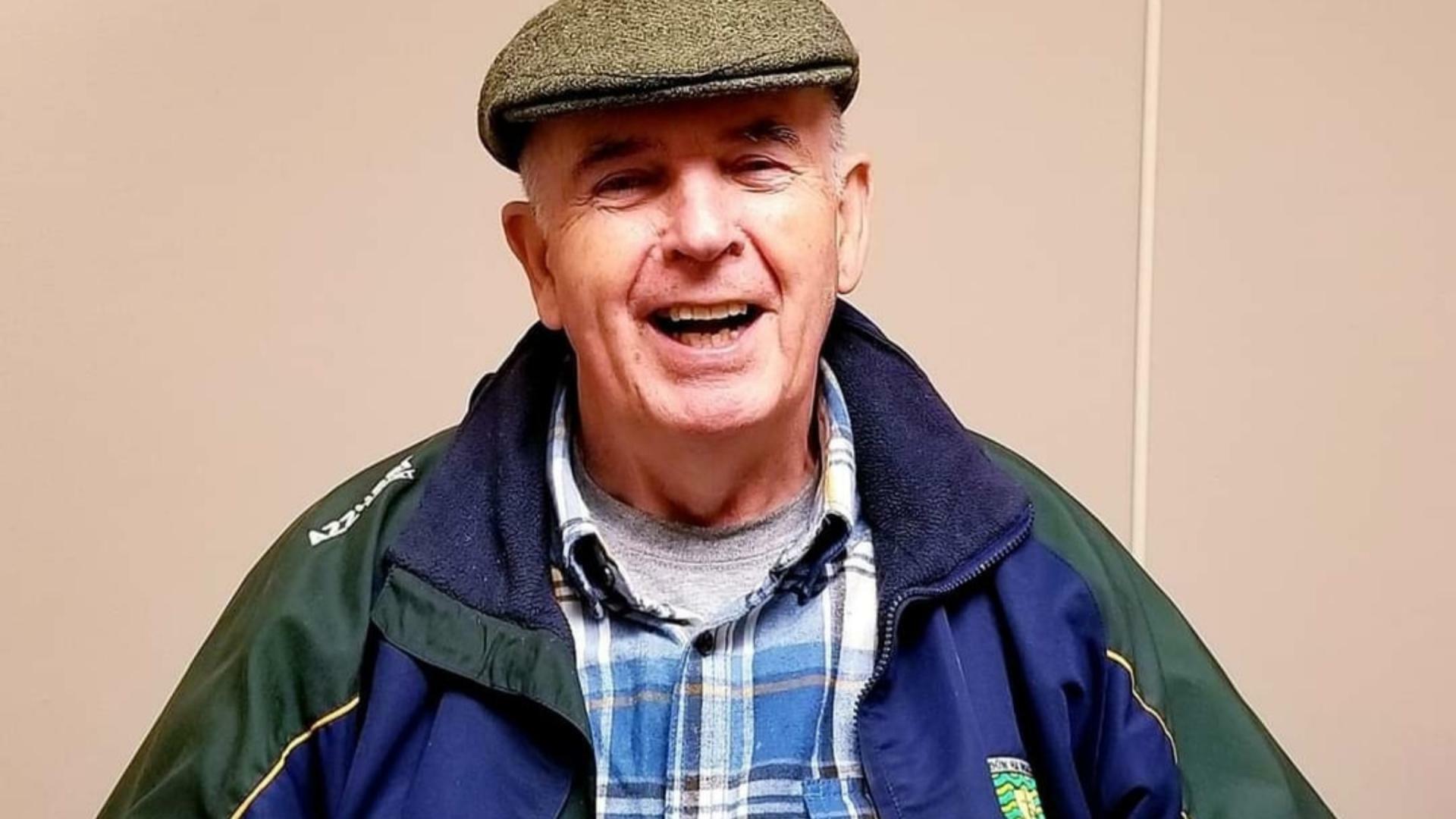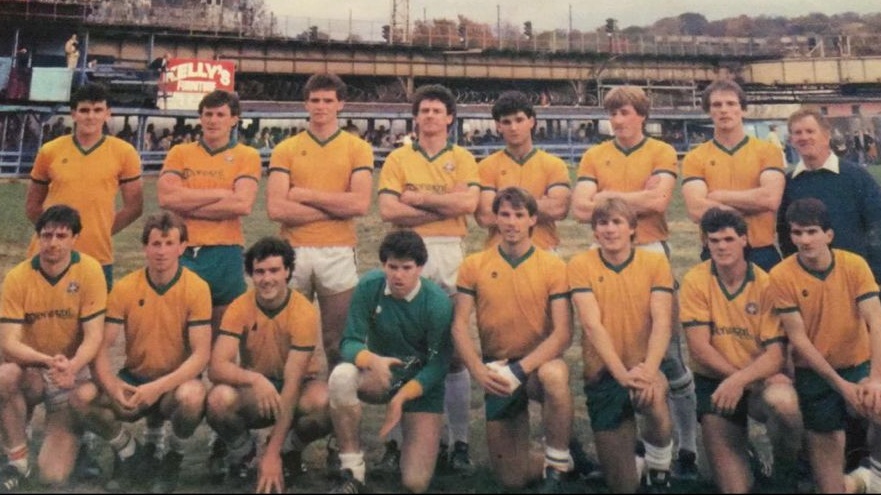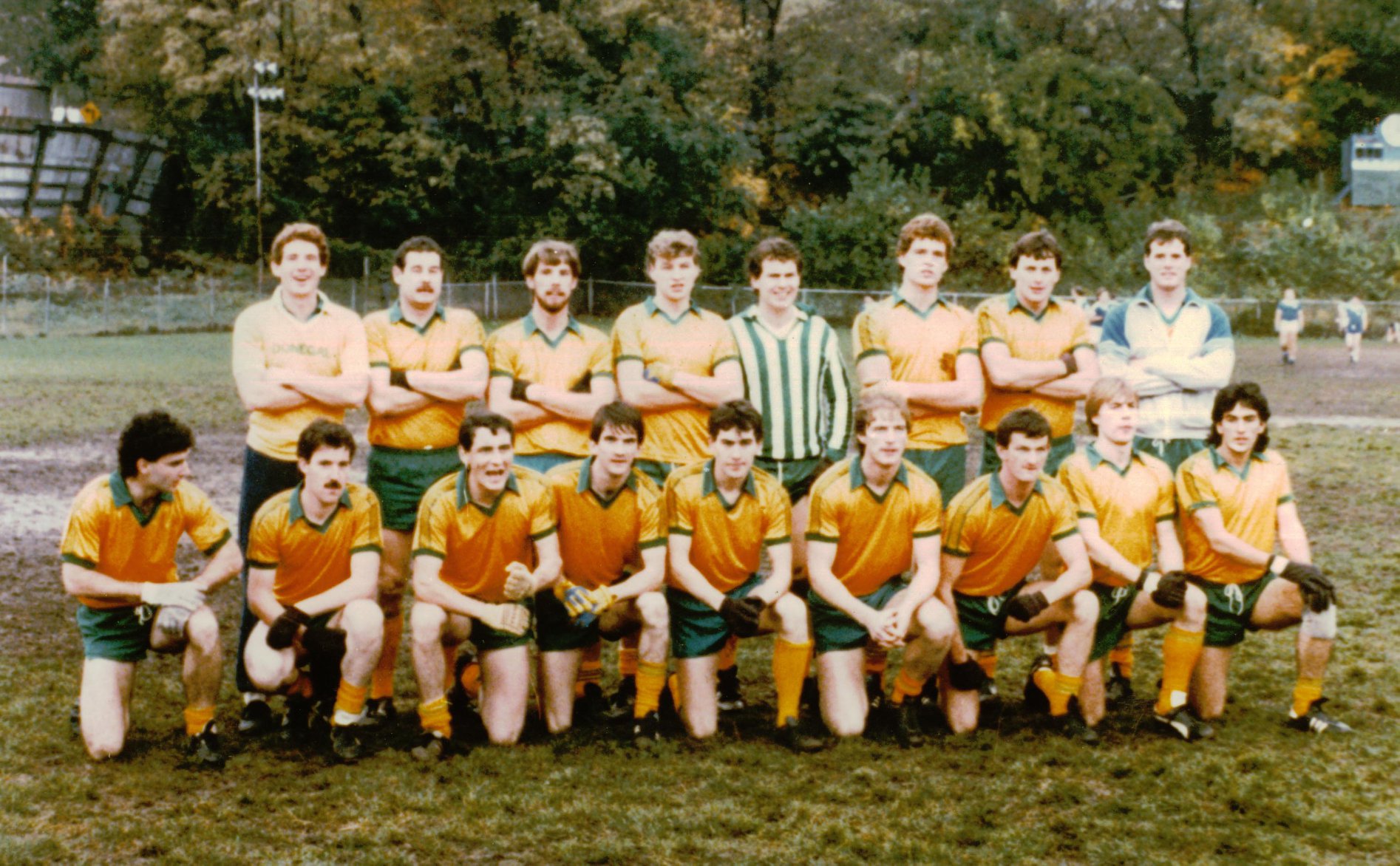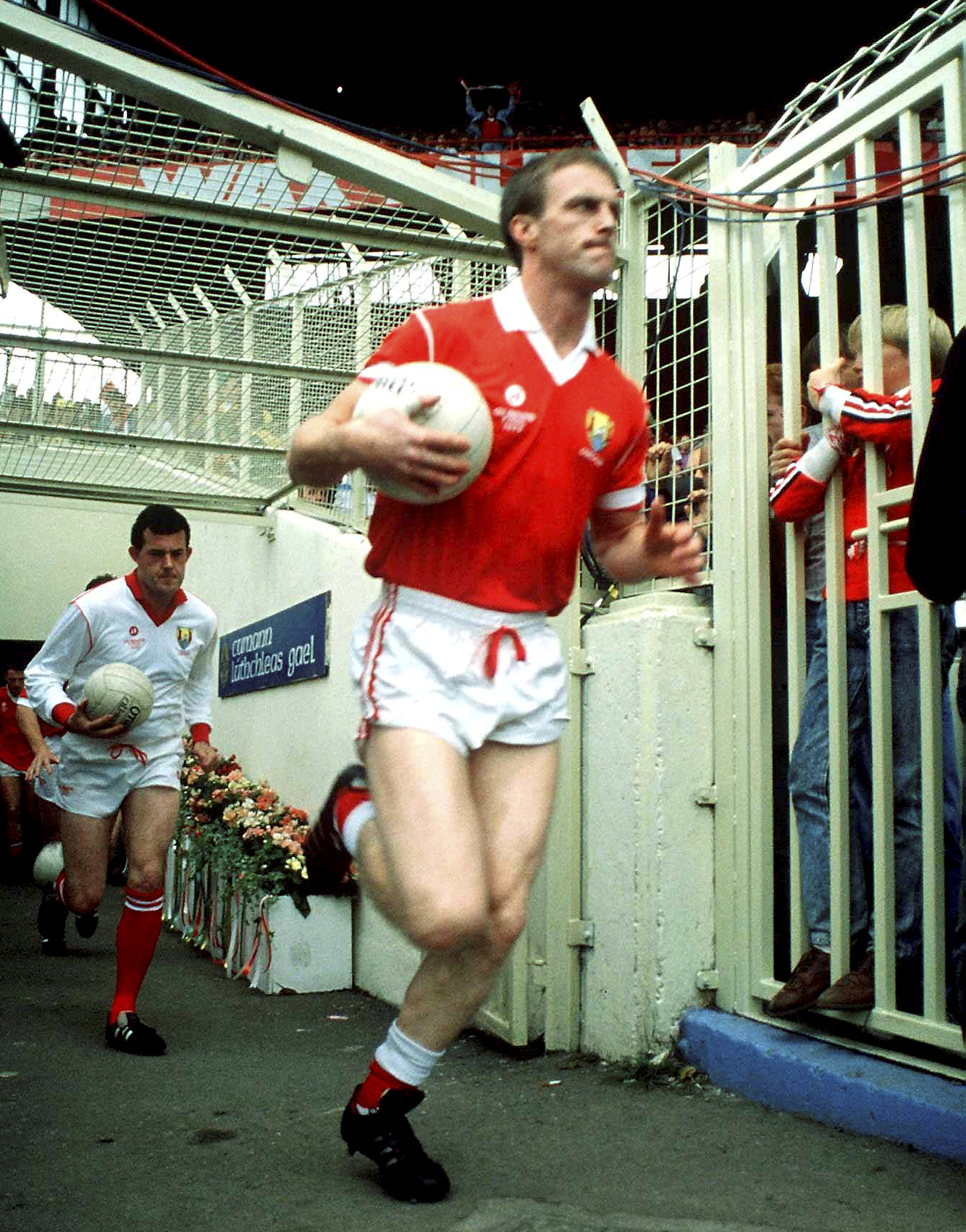
Larry Tompkins link with Donegal goes back a long way having played for Donegal/New York in the 1980s and winning four championships in-a-row with the club
It’s almost 37 years next month, the day of his 24th birthday, that Larry Tompkins boarded the train at Kent station to travel to Dublin for a challenge match in Parnell Park.
The most talked about inter-county transfer in GAA history was complete, Tompkins was officially a Cork footballer.
One of the finest players to ever grace the association’s fields would be born in Kildare, hone his skills in New York, and become a legend of the game in Cork.
But that period in the Big Apple is perhaps one of the most significant parts of Tompkins’ tale with his crossover with the green and gold of Donegal marked in history.
Many still put it down as a ‘what could’ve been’ moment if one of the finest forwards of his time settled north in the hills when he returned from the US in 1987.
He instead resided in Castlehaven where he captured two back-to-back All-Ireland titles with the Rebels. For the Eadestown man and the GAA, it could be regarded as one of the big sliding-door moments in the sport.
With Ireland suffering from economic collapse in the 1980s, any young person looking to build a new life for themself, with the added bonus of playing GAA, the Bronx was the destination for many, a place that Tompkins admitted changed his life.
But the future three-time All-Star was no ordinary Joe. He played five years with the Kildare U-21s, guiding them to a Leinster title in his final season.
He was an inter-county senior at 16, making his debut at Dr Hyde Park, with the late Jimmy Magee remarking on commentary that it must be some sort of record that a lad that young could play at that level.
He would remain loyal to the Lilywhites throughout his time there, even travelling home from the Bronx to Ireland to play for Kildare. He admitted that Kildare football was his passion, but off-field issues and politics held them back.
He was frustrated with how everything in Kildare was conducted, but Ticketgate was the breaking point for him.
In refusing to pay for Tompkins’ plane ticket back to the States as promised, in order to save some money, the county would pay a much greater price with Tompkins refusing to ever play for Kildare again.
Already a rising star, it was in the US with Donegal New York where the now Cork legend became infamous. He was famously, at one point, dubbed King of Gaelic Park, where he mastered his craft with the green and gold. But how did his connection with Donegal begin?
“I remember I just got a phone call from the late Donal Gallagher from Donegal, he was one of the finest men I ever met in my life, a true gentleman, but he just simply asked would I come on board and play for the Donegal club in New York, so that’s where it started in the early 80s,” Tompkins told Donegal Live.

“I suppose my initial contact was with a man called Mick Wright from Offaly, and he informed Donal that there was a guy from Kildare who was in America the year previous and was looking to play football for the summer, so Donal phoned me up and asked would I play one game, and look, I ended up playing for them for five years.
“My contact with Cork just happened randomly when I became friends with a lot of Cork people in New York, they convinced me to play club football with Castlehaven and eventually I transferred to the Cork county team, and as they say the rest is history.”
In fact, his King of Gaelic Park nickname came from a Cork gentleman, working in O’Grady’s Pub in Manhattan and playing for Leitrim New York – Billy Morgan, and that’s first where the seed was sown for Tompkins’ Cork future.
But his time with Donegal New York saw him achieve unbridled success, winning four New York championships in-a-row. Over the next few seasons the likes of Jack O'Shea, Ross Carr, Pat Spillane, Aidan Wiseman of Louth, Ciaran Power of Waterford, and Martin McHugh would all be added to the late ‘80s mix as Donegal New York dominated.
“I was coming over and back from Ireland to America during that time, and I’ve always said my best ever time playing sport was in America with Donegal New York, they were a fantastic club with some great people. It was a brilliant five years of my life,” Tompkins said.
“Playing in New York at the time was big stuff, there was no messing really and with the number of Irish leaving Ireland for America at the time, the standard of football was excellent. I would call New York at the time home from home and the competition was serious.
“Donegal was probably the best of the lot out there, they were tough championships to win, and I think we won four in-a-row, so funny enough, obviously people talk about my time with Cork, but my success started with Donegal to be fair.”

His time with the Donegal team saw him buddy up with several Cork and Castlehaven players on the team. When they returned to Cork to play with their club, the resulting factor saw them take Tompkins with them.
“Castlehaven is a very small club, so it was amazing to think that four of the lads from that area were playing for Donegal New York, the Collins brother Anthony and Vincy, Martin O’Mahony and Martin Connolly. It’s hard to believe that a small club in rural Ireland in the depts of west Cork, you had four lads playing in New York,” he said.
“That’s how the connection started, it started as a joke first that I would go back and play for Castlehaven, but eventually it got a bit real, and the rest as they say is history.”
No longer a Kildare player, there always remains that niggling feeling about what would’ve happened if the Donegal County Board or then team manager Tom Conaghan came calling for Tompkins first.
“I think people in Donegal spoke afterwards and admitted they were a little bit slow in trying to transfer me up north. Who knows, if they were a bit quicker, I could’ve played for Donegal, but it just so happened I went to Cork.

“Listen, it probably would’ve been as easy going to Donegal than Castlehaven in terms of travel, but that’s the way life goes. You turn the corner one day and in the blink of an eye your life changes.
“It’s hard to know what would’ve happened, I think the McHughs and Joyce McMullin were the forwards at the time . . . I’m not sure I would have started ahead of them; they were serious players.
“But my whole thinking around playing football back in Ireland was just centred on playing for Castlehaven, there was no talk about playing with Cork at that stage, it was just when the county secretary Frank Murphy got his teeth in the situation, he was determined to get me an inter-county transfer.
“But even when I was playing with Cork, I was still travelling over to New York to play for Donegal. You could say I was living my life out of a suitcase back then. It was the high life to a degree, and they were the best times of my life.”
One of the players who crossed paths with Tompkins on a number of occasions was future All-Ireland winning captain Anthony Molloy. In his autobiography, ‘A Memoir of Life, Glory and Demons’ he spoke about the drive the future Rebel star had at that time.
“Larry was a physical specimen. And as well as being a ferocious trainer, I'd often spot him heading around the block – gear bag on shoulder - to the local gym. He was lifting weights at the time. This was 1986. Don't forget the Donegal senior football panel, and only when Jim McGuinness came in, didn't start proper strength and conditioning programs until 2010. Tompkins was so far ahead of his time,” Molloy said.
Tompkins would eventually receive his transfer and take up his legendary position at half-forward for Cork for the first time in 1987, he would still return to New York and play for the Donegal team out there for another year.

And while he remembers fondly about the great footballing memories out there, more so, he recalls the Donegal community that took him in and embraced him during a period of hardship in Ireland. Something Tompkins said he will never forget.
“I think those times in New York, you’re young and the world is your own, those times instilled massive friendships. I had great respect for people like Anthony Molloy and his family, they were great players,” he said.
“I think you have to look at it in the context that people were very isolated and on hard times, and a lot of people were forced, more than anything, to leave Ireland for a better life, and it was the Donegal community out there who really helped so many people, including myself.
“Donal Gallagher deserves great credit, he bonded the team and the people together. He trained us hard, and it resulted in us going unbeaten for four years. I don’t think that’s been done since.”
Tompkins would finish that decade an All-Ireland winner in 1989, having lost the two previous finals to Meath, before going back-to-back in 1990. He wouldn’t play for Donegal in New York much after that but recalls coming in contact with some of his old comrades from the States at inter-county level back home when Donegal and Cork would square off.
“I remember playing against a lot of those Donegal players at county level when I moved home. We never faced each other in the championship though,” he said.
“I think Donegal lost to Meath in 1990 and we played Meath in that year’s All-Ireland final. Donegal also lost to Derry in 1993 and we met them in that year’s final, but I faced them a number of times in the league.
“I think that Donegal team were probably unfortunate not to win more back then. They had great players. You talk about Molloy and McHugh being real leaders, but then they had Manus Boyle and Declan Bonner who were brilliant forwards. I think it was Matt Gallagher who was tasked with tracking me a few times, so they were an all-round great side.”
When Tompkins looks back on his illustrious career, he’s happy to put a large part of Donegal beside it.
Subscribe or register today to discover more from DonegalLive.ie
Buy the e-paper of the Donegal Democrat, Donegal People's Press, Donegal Post and Inish Times here for instant access to Donegal's premier news titles.
Keep up with the latest news from Donegal with our daily newsletter featuring the most important stories of the day delivered to your inbox every evening at 5pm.